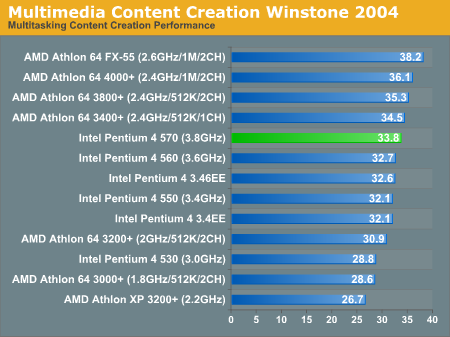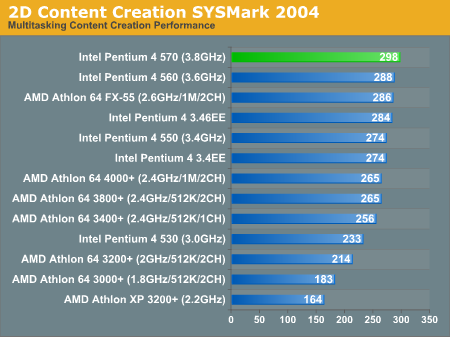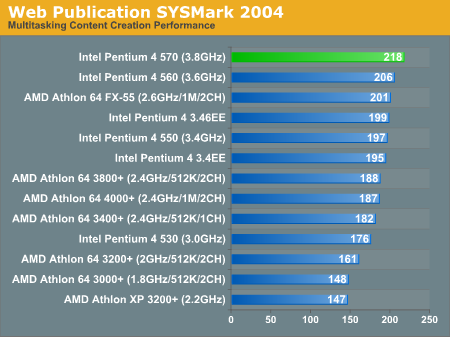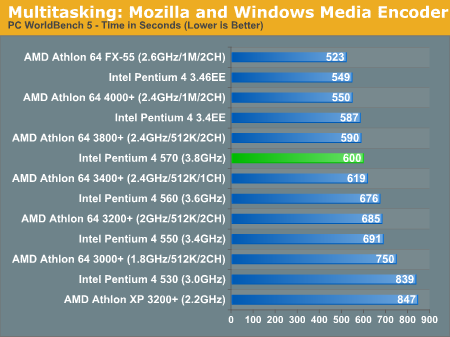Intel's Pentium 4 570J - Will 3.8GHz do the trick?
by Anand Lal Shimpi on November 14, 2004 10:56 AM EST- Posted in
- CPUs
Multitasking Content Creation
MCC Winstone 2004
Multimedia Content Creation Winstone 2004 tests the following applications in various usage scenarios:
. Adobe® Photoshop® 7.0.1
. Adobe® Premiere® 6.50
. Macromedia® Director MX 9.0
. Macromedia® Dreamweaver MX 6.1
. Microsoft® Windows MediaTM Encoder 9 Version 9.00.00.2980
. NewTek's LightWave® 3D 7.5b
. SteinbergTM WaveLabTM 4.0f
As you can see above, Lightwave is part of the MCC Winstone 2004 benchmark suite. As an individual application, Lightwave does manage to get a healthy performance benefit with multithreaded rendering enabled, especially when paired with Hyperthreading enabled CPUs like the Pentium 4s here today. All chips were tested with Lightwave set to spawn 4 threads.

ICC SYSMark 2004
The first category that we will deal with is 3D Content Creation. The tests that make up this benchmark are described below:
"The user renders a 3D model to a bitmap using 3ds max 5.1, while preparing web pages in Dreamweaver MX. Then the user renders a 3D animation in a vector graphics format."

Next, we have 2D Content Creation performance:
"The user uses Premiere 6.5 to create a movie from several raw input movie cuts and sound cuts and starts exporting it. While waiting on this operation, the user imports the rendered image into Photoshop 7.01, modifies it and saves the results. Once the movie is assembled, the user edits it and creates special effects using After Effects 5.5."

The Internet Content Creation suite is rounded up with a Web Publishing performance test:
"The user extracts content from an archive using WinZip 8.1. Meanwhile, he uses Flash MX to open the exported 3D vector graphics file. He modifies it by including other pictures and optimizes it for faster animation. The final movie with the special effects is then compressed using Windows Media Encoder 9 series in a format that can be broadcast over broadband Internet. The web site is given the final touches in Dreamweaver MX and the system is scanned by VirusScan 7.0."

Mozilla + Media Encoder
While AMD dominated in WorldBench 5's Mozilla test, encoding a file using Windows Media Encoder in the background not only makes this test more appreciative of the Pentium 4 but also of Hyper Threading.











42 Comments
View All Comments
mrdudesir - Monday, November 15, 2004 - link
Great idea including the Benchmark summary tables at the beginning of the article. I for one don't like having to always comb through the benchmark tables and pick out each specific test when its just a new processor being introduced. Keep up the great work guys.thebluesgnr - Monday, November 15, 2004 - link
To include IE render times you have to keep in mind that it's also very dependent on the chipset. If you really wanted to compare the two processors ideally you would use two motherboards with the same southbridge (SiS, VIA and now ATI).jimmy43 - Monday, November 15, 2004 - link
A lot more often than i make spreadsheets in excel.KristopherKubicki - Monday, November 15, 2004 - link
jimmy43: Although IE render time is a good test, Windows startup times seem kind of pointless. How often are you restarting your PC?Furthermore, virus scans are almost entirely bottlenecked on the HD.
Hope that helps,
Kristopher
jimmy43 - Sunday, November 14, 2004 - link
Personally, I would love to seem some actual real world benchmarks such as these:-Windows Xp startup times.
-Internet Explorer startup/render time.
-Virus scan times
-THOROUGH multitasking tests.
I really dont understand why these are not included. Most uses will spend 90% of their time doing such tasks (except gaming, where AMD is the obvious leader) , and as such, these benchmarks are CRUICIAL. Obviosly, one can extrapolate results for these from synthetic benchmarks, but i personally would much rather see real world benchmarks. Thank you!
skunkbuster - Sunday, November 14, 2004 - link
i personally never put too much stock in synthetic benchmarksbut thats just me
Xspringe2 - Sunday, November 14, 2004 - link
Woops sorry wrong comment section :)Xspringe2 - Sunday, November 14, 2004 - link
Do you guys plan on testing any dual opteron nforce4 motherboards?stephenbrooks - Sunday, November 14, 2004 - link
Well saying their recommendation is split doesn't mean to say it's split _equally_. ;)KeithDust2000 - Sunday, November 14, 2004 - link
Anand, you say "Had AMD released a 2.6GHz Athlon 64 4000+ Intel would have had a more difficult time with the 570J, but given that things are the way they are our CPU recommendation is split between the two."I don´t think it´s a good idea to recommend the 3.8Ghz P4 at this point. While A64 still has the advantage of Cool´n´quiet (while INTEL has rather the opposite), apparently INTEL thinks 64bit support (and Cnq)
is important enough to introduce for desktops next quarter. As you know, 64bit can e.g. speed up applications like DIVX encoding by 15-25%, others even more, and will give a performance advantage of roughly 1 speed grade or more rather soon. Not taking that into account, and recommending the rather future-unproof 3.8 Ghz P4
doesn´t seem wise at all. You´ve seen in the Linux tests as well what AMD64 is capable of. Buying a 32bit CPU for more than $600 now just looks like a dumb idea at this point.